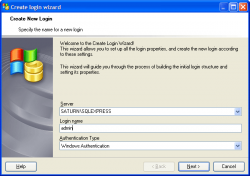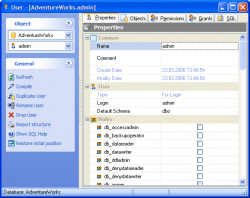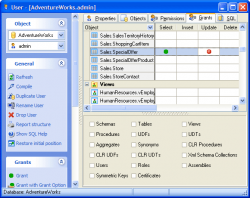MS SQL Maestro: Product Tour
Users, Logins, Roles
All the power of high-capacity Microsoft® SQL Server™ security system was realized in a few elegant wizards and editors. Creating and editing a login account are not exceptional actions with MS SQL Maestro. Just follow Create Login Wizard' steps to get a new login of any available type: Windows Authentication, SQL Server Authentication, and also Certificate, and Asymmetric Key for Microsoft SQL Server 2005. The Login Editor allows you to manage current login permissions. Along with a Server role Editor the editor is permitted to add/delete a login account to a necessary server role. |

|

|
MS SQL Maestro provides the easy-to-use graphical interface to manage MS SQL database users and their privileges. Create User Wizard and Create Role Wizard guide you through the process of creating a new user or a new role respectively. You can add a user to a role within the User Editor or Role Editor. The editors also allow redacting the user login and user database permissions. |
MS SQL Maestro allows managing access privileges (Grants) for Microsoft® SQL Server™ users and roles in the simplest way. Suppose, the user John may have Insert privileges on the table Employee. Just open the User (John) Editor and set there the necessary grant. At the same time you can open the Table (Employee) Editor to specify the user permission. Consequently, when specific privileges for selecting, inserting, updating, deleting, referencing an object (e.g. table, procedure, view, etc.) are given, the object acquires the corresponding Permissions indicating which user or object was given a Grant. |

|
| Back | Next |




